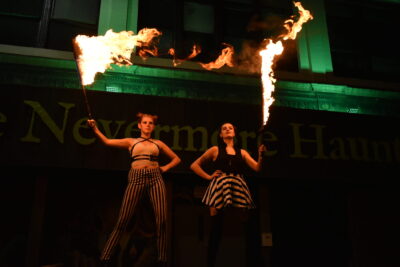20 Tips and Tricks for Haunt Scare Actors
By Isaac
Some tips and tricks for aspiring haunt actors, this time with 100% more tips!
Scare acting is one of the most fun seasonal jobs for people who love Halloween. Folks from a wide variety of backgrounds come together every October to dress up in scary costumes, hide inside haunted houses, forests and hayrides all over America. It’s a strange, sometimes exhausting but always entertaining way to really get into the Halloween spirit. If this is your first season as a haunted house actor here are 10 tips and tricks from the staff at The Nevermore Haunt, Maryland’s scariest haunted house, to be the ghost with the most at your haunted attraction.
![]()
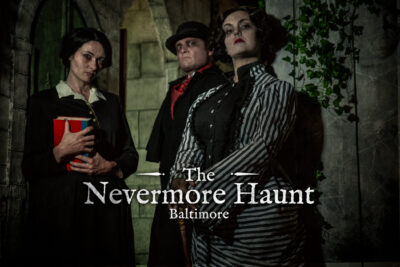
1 – Hydrate! Especially working at any of the haunted houses in Maryland, where the temps in October can still reach the 80’s well into haunt season. Bring yourself some water in a reusable container and don’t forget to drink it. During the adrenaline filled night of scaring and horrifying guests it’s easy to become dehydrated. Keeping hydrated will keep your energy up and your vocal chords fresh.
2 – Speaking of vocal chords; rest your voice and if you must scream or yell, be sure to do it from your diaphragm. It might be fun one night to growl, hiss or scream at every person that comes through your scene but Halloween season is a marathon not a sprint. Be sure to vary up your scare, include some non-vocal elements (like banging on a wall or using a noise maker) and when you do need to project make sure its from deep in your diaphragm not from your throat. You got to make that voice last till November!
3 – Create a character. Now, there’s no need here for an extensive backstory or even a name but it does help to think about what the ghoul, ghost or goblin you are representing is supposed to be doing in their scene. Are you an ax murderer looking for your next victim? A brain dead zombie? Or perhaps a vampire looking to suck some blood. This will help you come up with engaging lines and/or behavior that will make your scene stand out. When actors don’t do this they end up standing in a corner and yelling “get out” at every one that walks in the room. Don’t do this, it’s boring and not very scary.
![]()
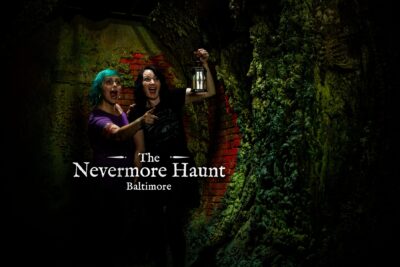
4 – You should work together with your castmates. Coordinating with your scene partners is a great way to effectively make your haunted house the scariest. Like in comedy, a ‘straight-man’ can help set another actor up for a great scare. Let one actor keep their attention while the other sneaks up from behind. Classic haunted house hijinks!
5 – Always scare forward! A common complaint for those going through haunted houses is what we call the “conga line.” This happens when groups get bunched up together as they move through the event. The easiest way to avoid this is to keep groups moving forward. If you pop out in front of a group they’re likely to stop or back up, starting a conga line. Scare from the side or the back and keep the group moving forward
6 – When you’re working out your routine, develop a circular scare path. On busy nights at your haunted attraction you will have many groups coming one after another. Resetting your scare can get difficult if you don’t have a good circular scare path. If you chase a group down a path, have a hidden way to move back to the beginning of the scene instead of back tracking. You never want to get caught with your back to a group, how embarrassing!
![]()
7 – Beware of repetitive movements to avoid injury. It might be no problem to squat behind a bush and jump out a few times or to swing that big hammer around and bang on that metal drum but if you do it a hundred times in a night you might be really sore the next day, you could even injure yourself. Know your limits and ease into a physically demanding scene.
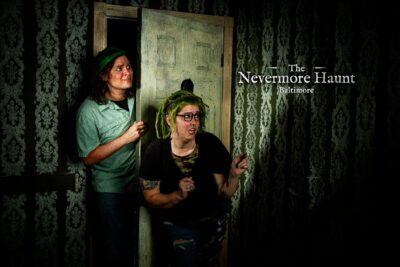
8 – You should also avoid or otherwise be very careful with the scarecrow routine. A scarecrow routine is any routine in which the scare actor pretends to be a prop and then moves suddenly when a person comes near. It’s a great, easy way to get a scream. It’s also a good way to get punched in the face. Unfortunately many visitors to haunted houses will be pretty rough with props, especially prop bodies. Its not uncommon to see people punch foam corpses or hit fake monsters. Pretend to be a prop and you’ll be shaking hands with danger!
9 – Develop an out for your routine just in case they don’t run and scream. So you’ve got your chainsaw, you rev it up and appear from behind a tree. You start running toward a visitor… and they just keep walking. Now you’re right on top of them, revving that chainsaw as much as you can, but nothing. Be assured that continuing to run that motor isn’t going to get you a scare and now the entire interaction is getting awkward. This is why you need an out. It could be as simple as continuing to run past the unshakable guests when you don’t see them running in fear. Perhaps you come up with a joke or find some other reason to disengage that keeps you in character. Anything is better than continuing to try to get a jump scare, you get one shot and if you miss it, move on.
![]()
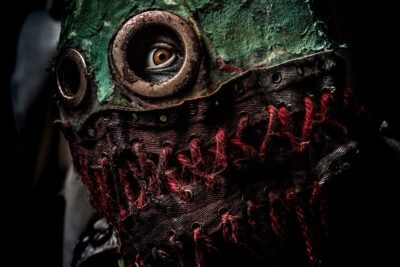
10 – Build a repertoire of comebacks. When people come through a haunted house and experience your routine they will often try to crack jokes. This is a common defense mechanism. Unsurprisingly most people aren’t that clever so you will start to hear the same comments night after night. Improv with visitors to the haunted house can be difficult but since they’re saying the same things over and over, use that to your advantage. Take downtime between scenes to come up with some real zingers and next time someone cracks a joke about your ‘bad breath’ you can have the group in awe of your amazing
11 – Comfortable shoes are a must. It is typically pretty dark in haunted houses and most of the time visitors aren’t looking at your feet. Wearing shoes that fit the theme of your costume is great and all but when it comes to shoes you’ll always want to prioritize comfort over aesthetics. Trust us.
12 – In a similar vein as above, wear a practical costume. Save the impossible-to-get-on-and-off, hot, cumbersome and bulky costume for cosplay conventions. Scare acting isn’t the place. If your costume looks amazing but you can’t move freely in it you’re going to have a bad time. That said, we all have varying levels of tolerance to discomfort so what works for one actor might not work for you. This also sometimes doesn’t apply if you’re working in the front-of-house areas but in general, if you can’t run and jump around in it it’s probably not going to work out.
![]() 13 – Don’t scream in people’s ears or make any other excessively loud noises near people’s heads. This is a huge annoyance for many haunted house visitors. If you are far away from people, make loud noise to get their attention. If you are inches from their ear a softer noise will do the trick and often be even more frightening. Try a loud whisper as you sneak up from behind, sometimes even just a heavy breath is enough to get people to jump.
13 – Don’t scream in people’s ears or make any other excessively loud noises near people’s heads. This is a huge annoyance for many haunted house visitors. If you are far away from people, make loud noise to get their attention. If you are inches from their ear a softer noise will do the trick and often be even more frightening. Try a loud whisper as you sneak up from behind, sometimes even just a heavy breath is enough to get people to jump.
14 – Hiding in plain sight can be a really effective way to get a scare. Sometimes new scare actors are convinced that the only way they will get a good jump scare is to be completely hidden and this just isn’t true. People coming in your scene are seeing it for the first time, often without being adjusted to the darkness and usually busy taking in the scenes and props that are laid out for them. It’s surprising how rarely they will notice someone standing just off to the side of the room. You can often scare people even better when they know exactly where you are. A sudden unexpected (or even completely predictable) movement will often send groups jumping. Anticipation is your friend when you’re looking to scare someone. A side benefit to hiding in plain sight is that you have better visibility on the scene and can more easily find your mark.
15 – Make a joke or be weird, you’re not always going to get a scream. Read the audience and consider alternatives to trying to terrify every group. While working in a haunted house you’ll encounter a number of different types of visitors. A group of haunted house aficionados taking in the scenery might be more entertained by some really bizarre but in character behavior. Perhaps a group of adults who enter your scene laughing might enjoy a bit of slapstick or a funny line over another attempt at a jump scare.
![]()
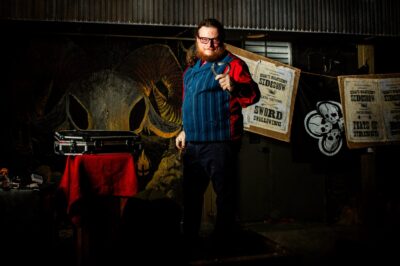
16 – It’s always a good idea to report busted sets or broken props. This advice is really just practical safety advice. The operators of the event and tech crew will always appreciate a heads up if you come across anything that is broken in your scene. Not only do broken props and scene decor detract from the experience, they can also be dangerous. Talk to your haunt supervisor or manager about the best way to report these sorts of issues. Also, try not to be the reason that these things are broken 🙂
17 – Things will break in the haunt, that’s why there’s usually a tech crew. Don’t bring any personal belongings you don’t want destroyed into the haunt. You might be tempted to bring that really cool, expensive prop you bought off etsy or a costume piece a friend made for you years ago to the haunt to use in your scene. If you’re going to be upset when it gets broken, don’t bring it. Haunted houses are notoriously rough on props and costumes, things can get a little crazy when people are running and screaming in the dark.
18 – Remember the importance of iteration! If something isn’t working you don’t necessarily need to change the entire routine. Make minor changes, adjust your timing, your position in the scene or the way you deliver your lines. Sometimes a minor change can make a routine pop. Think of each group as a single data point and experiment, experiment, experiment! Find what works and build on that, scrap what doesn’t work. Now you’re a spooky little social scientist!
![]()
19 – Sometimes you’re going to flop, especially when you’re new to scare-acting. Don’t be discouraged. A good strategy we often go with is to start new actors out mimicking someone else’s routine. Ask what others do when they work your scene, where they hide, what they say and how they get a scare. Start there and then iterate on that. Before you know it you’ll have your own movements, adjusting your hiding spot and developing your own repertoire of lines. By Halloween night you’ll have a scene and routine that’s all you.
20 – Don’t sweat the jerks, they’re like that to everyone. It’s just a fact of life that some people just suck and that some of those people will come through your haunt. They’ll say awful things, they’ll behave in ways that are disrespectful and they might get a kick out of trying to get under your skin. When you run into visitors like this just move along. They’re really not worth your time, save your energy for the folks who came out to have a good time. If the bad behavior crosses the line, remember that your safety is your number one priority. Your second priority is to be sure to report them to your supervisor or manager. You should ask the folks running your event how they handle reports about bad patron behavior. At our event we provide radios in scenes in case of incidents but every haunt is different. Reporting problem behavior can help the event management ensure that everyone is safe.
Happy Haunting, from everyone at The Nevermore Haunt
